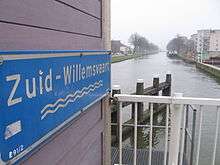Zuid-Willemsvaart

The Zuid-Willemsvaart (Dutch: [zœytˈʋɪləmsfaːrt]; translated: South William's Canal) is a canal in the south of the Netherlands and the east of Belgium. It provides a shortcut in the river Meuse between the cities of Maastricht and 's-Hertogenbosch. The canal was named after King William I of the Netherlands, with "South" added to avoid confusion with two other canals commissioned by and named after the King: the Willemskanaal near Zwolle and the Noord-Willemskanaal in the province of Groningen.
King William ordered the planning of the canal, and construction started in 1823. The canal was completed in 1826 and named for the king. The 123 km-long canal runs through the Belgian province of Limburg, the Dutch province of Limburg and, for the largest part, through the Dutch province of North Brabant. At the time of the canal's construction, all of these regions were part of the United Kingdom of the Netherlands (1815–1830/39).
The canal created new possibilities for development of the poor towns on the sandy grounds of North Brabant, such as Helmond and Veghel and created an alternative traderoute for ships that did not want to sail the Meuse.
Nowadays the cannal is being enlarged to make more room for ships with higher tonnage and therefore the development of larger industries.
| Wikimedia Commons has media related to Zuid-Willemsvaart. |